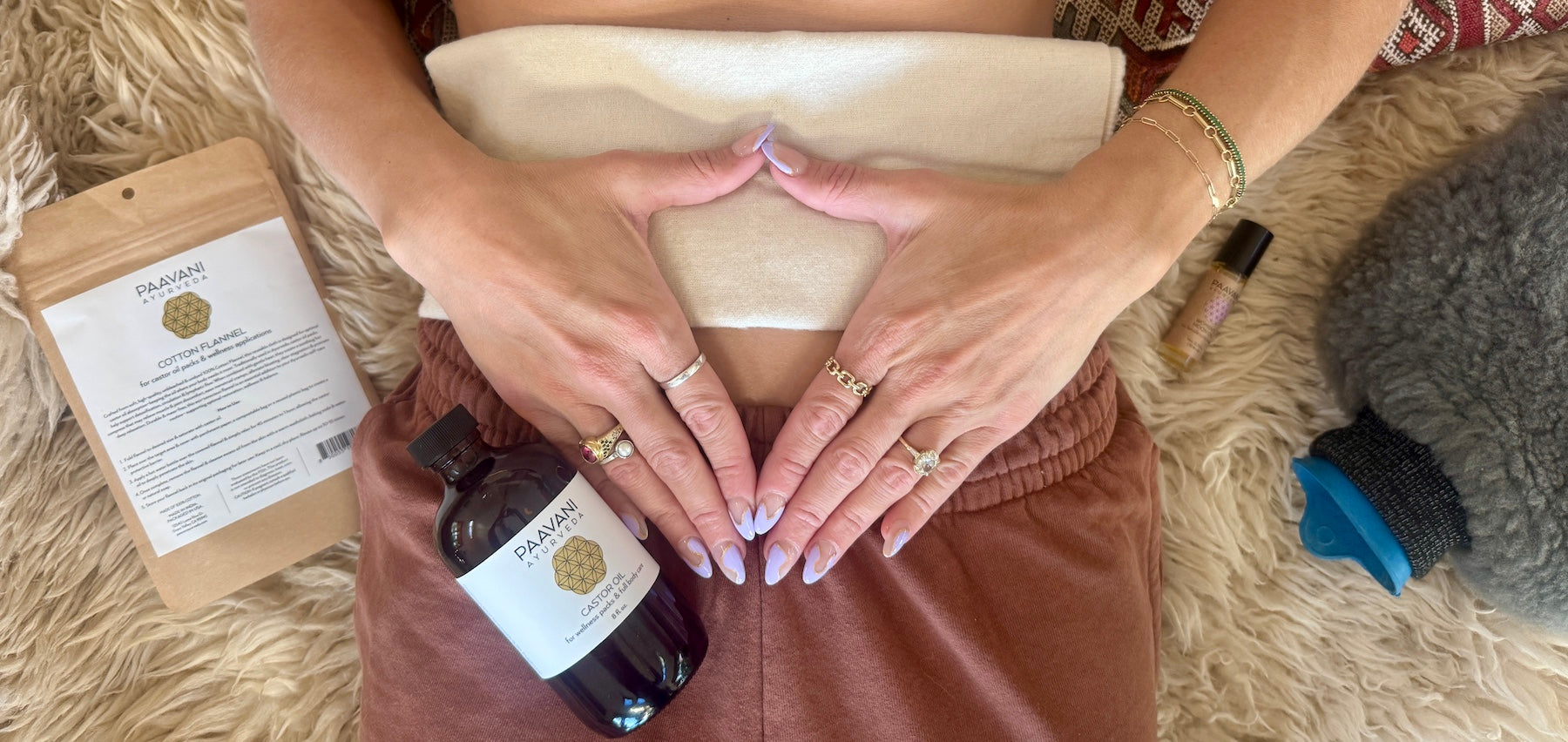
An Ayurvedic Guide to Understanding & Balancing Your Menstrual Cycle
Your menstrual cycle is more than a monthly occurrence. It is a mirror of your inner balance, vitality and connection to nature’s rhythms. In Ayurveda, menstruation is viewed as a sacred detoxification process, an opportunity to release, renew and realign with each cycle. This month, as we celebrate the Devi, the divine feminine energy within all beings, we take this opportunity to deepen our connection to the womb, considered in Ayurveda the seat of Shakti and the source of creation. Honoring the Devi goes beyond rituals and mantras; it’s about attuning to the voice of the feminine within and caring for her through intentional embodied self-care.
Your cycle is one of the most tangible ways in which the Devi speaks through your body. Yet for many, it is accompanied by discomforts such as PMS, cramping, irritability, bloating and fatigue. These symptoms are signs of doshic imbalance and can often be eased through Ayurvedic self-care practices.
In this guide, we will explore how to understand your menstrual cycle through the Ayurvedic lens, how to identify doshic imbalances and how to support your system with the proper diet, herbs and lifestyle practices, including our new Castor Oil Pack for optimal menstrual wellness.
The Ayurvedic Perspective on Menstruation
A healthy menstrual cycle flows with the rhythms of the lunar calendar and is governed by apana vayu, the downward-moving energy responsible for elimination, menstruation and letting-go. In Ayurveda, a balanced cycle is not only regular but free from pain and disruptive symptoms. When this rhythm is disturbed, it often signals an imbalance in one or more of the three doshas: vata, pitta or kapha. Modern influences like poor diet, chronic stress, disrupted sleep, emotional overwhelm or overstimulation can all contribute to these imbalances. PMS, for example, is typically caused by excess vata dosha, although it could also manifest as a vata-pitta or vata-kapha imbalance depending on the unique symptoms.
What Your Cycle is Telling You: Dosha Imbalances & Ayurvedic Support
Vata Type PMS
Symptoms:
Irregular, light, scanty &/or painful periods
Anxiety or insomnia,
Tenderness in the breast tissue
Bloating or gas
Feeling ungrounded, spacey or overly sensitive.
Ayurvedic Remedies:
Eat warm, moist, grounding foods like stews, cooked grains and healthy fats. For more vata-pacifying foods, explore our Vata Balancing Foods List .
Avoid cold, raw and dry foods, as well as overstimulation or late nights.
Practice gentle yoga, nature walks, restorative yoga postures & nadi shodhana (alternate nostril breathing)
Herbal allies: Ashwagandha for stress support, Shatavari as a moisturizing, reproductive tonic, Licorice to soothe and hydrate bodily tissues & Cumin to expel gas and bloating.
Emphasize grounding practices such as a warming, nourishing Castor Oil Pack, Golden Milk or Women’s Blend Tea.

Vata-Pitta Type PMS
This type of PMS occurs when both vata and pitta doshas are vitiated or imbalanced. The major difference between this condition and a vata type condition outlined above is the heated quality as pitta dosha is hot, sharp and fiery.
Symptoms:
Strong or heavy menses for the first few days that tapers off toward the end due to the hot, mobile nature of pitta dosha in the rakta dhatu, or blood channel.
Skin rashes and acne Irritability and angry outbursts.
Inflammation that can create headaches, diarrhea &/or swelling and tenderness in the breast tissue.
Ayurvedic Remedies:
Favor cooling, calming foods such as cucumber, leafy greens, mung dal and sweet fruits. For more pitta-pacifying foods, explore our Pitta Balancing Foods List .
Avoid spicy, fried or overly salty meals.
Cooling yoga and soothing movement such as swimming, slow vinyasa and breathwork with moon imagery.
Herbal allies: Shatavari as a moisturizing, reproductive tonic, Brahmi to support mental calm, Rose for inflammation relief and Coriander to balance a hot and/or acidic agni(digestive fire)
Castor Oil Pack yet, because Castor Oil is heating, it is recommended to only do this ritual for a short period of time, around 10-20 minutes to balance vata without vitiating pitta dosha.
Soothing rituals like a Coconut Milk Bath and our Women’s Moon Oil.
Vata-Kapha Type PMS
Symptoms:
Achy, dull pain
Weight gain due to water retention in the large intestine.Heavy, static, oily nature to the tissues, which creates stagnation and swelling in the rasa dhatu,or fluid channel.
Strong, steady and longer than any other period type, lasting seven to 10 days.
Feelings of depression, sadness and lack of motivation
Ayurvedic Remedies:
Embrace light, warming foods like quinoa, leafy greens, warming vegetables and citrus fruits. For more kapha pacifying foods, explore our Kapa Balancing Foods List.
Brisk walking, dancing and invigorating yoga can uplift and release the heavy, stagnant nature of kapha dosha.
Herbs: Tulsi offers an uplifting quality, Turmeric provides anti-inflammatory support, Pippali awakens lethargic agni and Sage provides an astringent quality to eradicate excess water retention.
Rituals: garshana (Ayurvedic dry brushing), as well as a Castor Oil Pack.
The Importance of Hydration
Regardless of your predominant dosha, hydration is essential to a smooth and supported menstrual cycle. Dehydration can lead to increased vata (dryness & cramping), intensified pitta (inflammation & irritability) and sluggish kapha (bloating & stagnation). Thus, Ayurveda teaches that it is beneficial to drink warm or room-temperature water, consuming at least half of your body weight in ounces per day. Herbal teas are also a wonderful way to stay hydrated and you can also infuse your water with rose petals or lemon for an extra boost of cooling or cleansing energy.
Proper hydration supports:
- Improved lymphatic flow.
- Easeful menstrual detoxification.
- Reduced cramps and water retention.
- Healthier skin
- A balanced mood

Castor Oil Packs: A Sacred Tool for Menstrual Health
One of the most effective, time-honored tools for women’s wellness is a castor oil pack. This soothing, deeply detoxifying practice softens the tissues, reduces inflammation and enhances the natural downward flow of apana vayu.
How to Make a Castor Oil Pack:
Saturate organic cotton flannel with Castor Oil.
Place the Cotton Flannel over your lower abdomen.
Cover with a towel and apply heat using a hot water bottle or heating pad.
Rest for 30-45 minutes in a comfortable position.
Use during the luteal phase (before your period), during your period or whenever you need extra womb support, hormonal balance and menstrual ease.
Try our Moon Cycle Stack, which includes our Castor Oil, Cotton Flannel and Women’s Moon Oil to prepare for your divine feminine self-care ritual.
Embrace Your Cycle with Ayurveda
With awareness, nourishment and ritual, your menstrual cycle can become a source of strength rather than struggle. At PAAVANI Ayurveda, we honor Devi energy through intentional herbal blends, therapeutic oils and time-honored tools to support your cycle at every stage.
Explore our Women's Wellness Rituals:
Slow Down, Listen & Honor
Embracing your feminine essence extends far beyond the month of honoring the Devi. Each cycle invites you to slow down, listen closely and honor the sacred rhythms of your body. When you treat your body as a temple and nurture it with love and respect, you strengthen your connection to the divine feminine within.
May this month and every month awaken your wellness, creativity and inner power.






Leave a comment
This site is protected by hCaptcha and the hCaptcha Privacy Policy and Terms of Service apply.